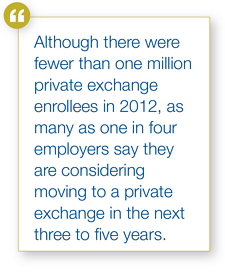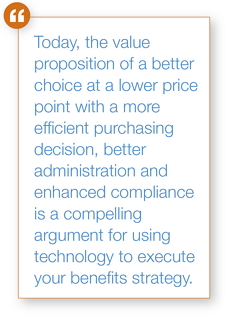Private exchanges alter the
way employee benefits are communicated, administered, selected and delivered.
(Excerpted from the on-demand webinar “Disruptive Technology - How New
Technology is Changing the Landscape of Employee Benefits and Wellness”)
Technology has changed the way we do pretty much everything these days. Shopping, filing taxes, working remotely, even hailing a cab – it’s all online. Now technology is going to change the way we administer, select and deliver employee benefits as well.
 Private employers are increasingly interested in exchanges as a way to facilitate high-deductible and consumer-driven health plans aimed at stabilizing health care costs and mitigating the 2020 Cadillac Tax on higher cost, gold-level health care
plans, while still providing an array of benefit options to employees. Exchanges offer a game-changing take on benefits “shopping” with embedded decision support tools and administration communication including tracking and reporting to ensure compliance. Although there were fewer than one million private exchange enrollees in 2012, as many as one in four employers say they are considering moving to a private exchange in the next three to five
years[1].
Private employers are increasingly interested in exchanges as a way to facilitate high-deductible and consumer-driven health plans aimed at stabilizing health care costs and mitigating the 2020 Cadillac Tax on higher cost, gold-level health care
plans, while still providing an array of benefit options to employees. Exchanges offer a game-changing take on benefits “shopping” with embedded decision support tools and administration communication including tracking and reporting to ensure compliance. Although there were fewer than one million private exchange enrollees in 2012, as many as one in four employers say they are considering moving to a private exchange in the next three to five
years[1].
“Over the last 20 years we’ve become complacent and inefficient in the way we design health plans and for that reason, we were likely over-insured. We didn’t have the technology and systems before to present a myriad of options in a way that wasn’t confusing,” said Mike Barone, national president, Employee Benefits, HUB International. “Today, the value proposition of a better choice at a lower price point with a more efficient purchasing decision, better administration and enhanced compliance is a compelling argument for
using technology to execute your benefits strategy.”

Barone warns that technology isn’t a strategy itself, but rather a tool to implement an organization’s strategy. “Employers have to be willing to push themselves out of their comfort zone and be better educated on new tools. Industries have been turned upside down by technology.
The same is happening to employee benefits.”
Why
a private exchange?
The private exchange platform offers a number of advantages to employers and their employees.
Benefits
Administration. With the ability to present all types of benefits plans, maintain eligibility data, integrate with human resources information systems and facilitate necessary reporting and compliance all in one online portal, exchanges remove manual
and paper-based processes, which reduces administrative headaches and expense.
More
Choices. Offering a metallic spectrum of benefit choices goes hand-in-hand with defined benefits or a defined contribution strategy. Private exchanges support high deductible and consumer-driven healthcare plans because they can present multiple offerings - from
standard to voluntary benefits all at once. With Amazon-like decision support tools to promote the “shopping” experience, exchanges feature personalized communication with an option to imbed video and facilitate communication with the individual based on how they are navigating the process in real time, with
the end game being ultimate plan selection.
Compliance. Exchanges feature variable hour tracking, pre-set notifications, ACA reporting capabilities and more –-facilitating the necessary reporting requirements with
state and federal governing bodies.
Reduced
Cost. Studies show that 60% of Americans use less than $1,000 in benefits every year. When offered a choice and more ownership in the decision making process, employees will make smarter choices at a lower price point.
Scalability. For organizations with anywhere from 50 to well over 100,000 employees, exchanges can be customized by plan selection and level of sophistication with the same decision support tools, reporting capabilities and benefits administration.
Employee
Engagement. The exchange platform increases employee engagement and allows for integration of tools and resources that increase “stickiness” for employees on a month over month basis by creating a platform for communications, education and all transactions related to benefits and retirement planning.
Where
to start?
With the ability to communicate, train and educate your employees through the use of a benefits exchange, Barone says corporate executives should think of exchanges the way they think about their business strategy – with key performance indicators (KPIs) and a
clear, thought-out three to five year plan.
Barone urges HR executives to ask themselves a few questions when considering an exchange:
- What is our core benefits strategy?
- How do we achieve the highest ROI?
- How can we best balance cost, quality and choice?
- How do we communicate benefits?
- How do we optimize ACA compliance and benefits?
The future of benefits technology
There’s no question that technology will continue to change the way Americans think about and access healthcare. Barone points to the $77 billion application industry with healthcare apps being the most accessed, as an example of how technology is changing
health care one step at a time. “The technology is out there to do just about anything these days and accessing and shopping for our employee benefits should be no different,” said Barone.
Contact your HUB employee benefits broker for more information on how a private exchange can help you minimize healthcare costs and maximize employee benefits options.
[1] Insight Private Health Insurance Exchanges Looming, Accenture